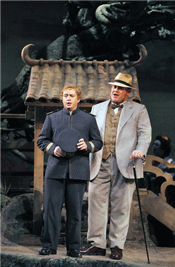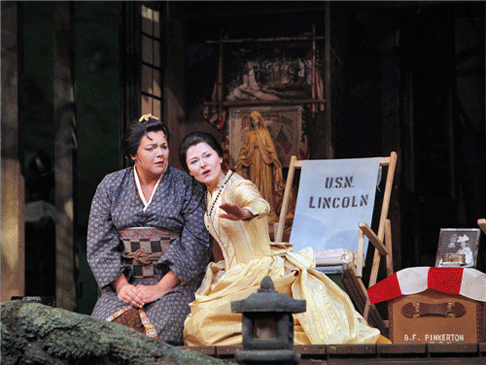24 Oct 2010
Madama Butterfly in San Francisco
“One of the most beautiful sets I have ever seen,” crows San Francisco Opera general director David Gockley over the airwaves, “directed by Broadway legend Hal Prince.”

“One of the most beautiful sets I have ever seen,” crows San Francisco Opera general director David Gockley over the airwaves, “directed by Broadway legend Hal Prince.”
He is trying to sell twelve performances of Puccini’s masterpiece presumably to the unwashed hordes who flocked to to see Aida simulcast from the opera house onto the scoreboard of the local baseball stadium. The problem is once you have got them inside the War Memorial what do they see?
No doubt Hal Prince is a brilliant Broadway director. Soon after his opera exploits (Willie Stark in 1981 [more a Broadway musical than an opera], Madama Butterfly in 1982 and Turandot in 1983) he went on to direct Phantom of the Opera (1986), the longest running musical in history.
 Stefano Secco as Lt. B.F. Pinkerton) and Quinn Kelsey as Sharpless
Stefano Secco as Lt. B.F. Pinkerton) and Quinn Kelsey as Sharpless
Yes, this is the Madama Butterfly he staged for Lyric Opera of Chicago. It caused a lot of excitement back in 1982, after all those theatrically savvy Broadway folks know how to put on a show. There was a national telecast so the production is well known, but back then the lighting seemed far darker so it was harder to see the Kabuki theater knock-off Koken spin the set, and it is harder yet to recall the staging itself after these 28 years.
In San Francisco just now those ninja-like Koken (lithe figures in black body stockings) convincingly simulated the massive efforts needed to turn the huge, fairytale, Las Vegas worthy love nest of Pinkerton and Butterfly. They were quite apparent, forcing the same question that arose back then — what does hyper-stylized Kabuki theater have to do with verismo (realistic) opera?
The answer is about as much as Broadway has to do with verismo opera. The play Madame Butterfly on which Puccini based his opera is by San Francisco’s own David Belasco. It is the American equivalent of théâtre guignol or French horror theater, a frequent Puccini muse. In Belasco’s Butterfly Cho-Cho-San’s horrific suicide is carefully prepared within grubby circumstances. It is reality best experienced, if you must, from a seat in a theater.
Broadway is typically fast and easy. There is lots of stimulation created by frequent scenic movement and lots of color. The story is direct and emotions are obvious. Thus in the Prince Butterfly the set is spun and spun, the colors are seductive and glittery. Butterfly boldly sheds her kimono in favor of American apparel. But the bright gold of her bustled Victorian dress belied three years of wear and the condition of extreme poverty required by the story. It did have requisite Broadway flash.
 Daveda Karanas as Suzuki and Svetla Vassileva as Cio-Cio-San
Daveda Karanas as Suzuki and Svetla Vassileva as Cio-Cio-San
The Butterfly was the diminutive Svetla Vassileva, a veteran of the world’s big stages to be sure but also an artist of considerable depth, and one who is game for interesting contemporary productions. Her Butterfly is intrinsically Belasco’s geisha, physically and emotionally clumsy (after all she is fifteen years old), simple and very honest. She is not a geisha who makes it to Broadway.
Nevertheless the misplaced glitz of the production faded in her presence, leaving Mme. Vassileva alone on stage to carry Butterfly’s tragic burden, and that she did, to a degree. She is in fine voice — a young and healthy one — well schooled in verismo technique. She tirelessly delivered all the great scenes. The production betrayed her in its absence of reality, her lover seemed a confused kid who found himself in an opera production because he sings well. The balance of the casting showed blatant disregard for the needs of both Belasco and Broadway, and Puccini too wants heavier, Italianate voices. Even the genius of San Francisco Opera’s quixotic conductor Nicola Luisotti could not save the day, though he tried with a breathtaking coda.
But don’t just take my word for it. Check out the video excerpt on the San Francisco Opera website.
Michael Milenski